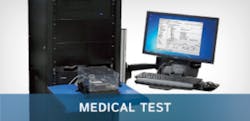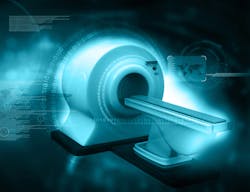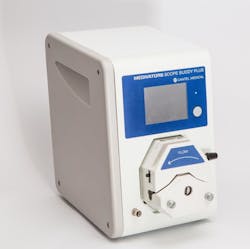Many smaller, less expensive medical devices also involve computer and electronics technologies that have improved accuracy and ease of use while adding new functionality. For example, Spacelabs Healthcare develops medical products to address applications in patient monitoring, diagnostic cardiology, and anesthesia delivery.
The company’s AKRON Anesthesia Delivery System is typical of the complexity associated with today’s medical products. As described on the company’s website, “This evolutionary anesthesia delivery system expands to enable a wide-angle view of the clinical setting so you can face your patient. Plus, it offers a host of additional clinical advancements, including:
- centrally located clinical controls for ease of use,
- a touchscreen display with intelligent navigation,
- an intuitive and highly customizable user interface,
- signature lighting to emphasize active controls,
- a rotating breathing circuit for bringing anesthesia delivery closer to your patient, and
- a full range of ventilation controls.”
A further range of features helps to manage the overall workflow in the operating room:
- a system status computer that communicates the state of the battery backup, inert gas pressure, gas scavenging, and machine checkout;
- seven electrical outlets distributed around the system;
- built-in USB and Ethernet ports; and
- convenient work surfaces and storage areas.
In another medical product example, extensive wireless communications functionality is the latest improvement to patient-worn fall-detection pendants—the small devices that can save a life should the wearer fall or in some other way become incapacitated and require help. A wireless base station is needed to support local short-range communication although newer devices include Wi-Fi capability.
A Keysight Technologies application brief1 provides good background information for these devices. It explains, “In the case of a fall or other emergency, the user can summon help with the touch of a button. This sends a call over phone lines or the Internet to a service representative who can call the user’s emergency contacts and/or emergency medical responders…. A downfall of traditional medical alert systems is that [they] require a phone or Internet connection for the base station unit. Another is that many systems’ pendants only operate within a specific distance from the base station.” The brief concludes by adding that new designs with “base stations that are wireless via cellular and pendants that support GPS and Wi-Fi as well as traditional methods” have become available.
Ensuring correct operation
As Averna’s Jim Bokos, vice president of global account-medical devices, asked, “Are there any devices more life-critical than those used by our doctors and nurses? You want to be absolutely sure that each one will work exactly as designed 100% of the time. That’s why there is so much oversight on the industry. Every player needs to get it right.” Bokos only mentioned doctors and nurses but clearly fall-detection pendants and similar wearable electronic medical products with safety implications also must be reliable and accurate.
You can’t add quality to a product by testing, so the initial design has to meet all the relevant standards as well as the specific customer requirements. Nevertheless, testing ensures that each item performs correctly after it has been manufactured.
The subtitle of this section also has another meaning—ensuring that the device is used correctly—and this aspect can be at least as important as the basic hardware/software performance. A 2014 article2 explores nine factors that can lead to medical device failure, and human error is near the top of the list.
In the order listed by the author, the factors are the following:
- startups with limited expertise,
- plain old human error,
- not employing human factors research,
- a bridge too far when it comes to errors,
- the lack of a good manufacturing practice,
- a poor corporate culture inside device makers,
- reusing devices that should not be reused,
- not involving the doctors, and
- not keeping other cultures in mind.
Some of these items may be related—one can envision a startup with a great product idea but didn’t involve doctors, didn’t conduct much human factors research, and only considered how the product might be used in the company’s native country. Reusing “disposable” items is related to poor management within the medical facility, although it may appear to be human error. “A bridge too far …” refers to the threshold that problems need to reach before they are considered to be serious. There could be a number of complaints, each about a separate area of a complex product, which when taken together indicate a significant problem.
System integrators can help
ISO 13485:2016, Medical devices—Quality management systems—Requirements for regulatory purposes covers the development of a quality management system (QMS). Because the safety of medical devices is critical, a formal QMS plan is required that demonstrates an organization’s ongoing commitment to product quality. The plan will address requirements, objectives, the actual process of developing and maintaining a QMS, responsibilities and authorities, communication of the plan within the company, and periodic review and correction.
A device manufacturer’s compliance with mandatory requirements such as ISO 13485 for a QMS or the FDA’s title 21 CFR Part 820 regulation that deals with risk assessment and mitigation strategies can be helped by involving an experienced test system integrator. For example, Circuit Check (CCI), the system integrator featured in reference 1, has built several medical device test systems around Keysight’s 34980A switch/measurement unit. Systems also can be PXI based.
According to the company’s CCI 1050 Medical Device Test Station Configuration Guide,3 the systems include “… user-configurable modules and high-level user-friendly test management software. CCI 1050 test stations can be deployed with board/product functional, RF, and flash programming modalities.
“Once [the test system is] configured with measurement hardware, CCI can include all the tools needed to support the software development lifecycle, including requirements management, code analysis and traceability, and unit tests. These deliverables can be used as a component to satisfy risk assessment and mitigation strategies outlined internally or by 21 CFR Part 820.”
In a CCI wearable fall-detection project overview presentation, it is recommended that collaborative requirements development between the device manufacturer and CCI are led by CCI. Once the requirements are defined, product and test development can progress concurrently.
As explained by CCI’s Greg Crouch, marketing and business development executive, “If CCI helps the customer with the specification phase of the tester [development]—that is, helping them to create the technical requirements specification (common with medical startups)—then we typically try to make the tester accommodate as little floor space as possible. The fundamental issues with medical production are verification of the tester, documentation, and limiting the number of touches [by] people handling the product throughout the process.”
He said that automation can be used in several ways, such as automated handling, although most often the test head is automated. Some CCI-provided details of a wearable fall-detection base-station tester include the following:
- industrial, scientific, and medical (ISM) radio test at 917 MHz,
- embedded GSM and WCDMA cell phone signaling,
- RF nonsignaling tests,
- audio loopback tests,
- rub and buzz speaker test,
- POTS DTMF and on/off hook phone tests, and
- automated connector insertions and switch actuations.
Averna also is active in medical device test-system integration. As discussed by the company’s Bokos, “… constant changes mean companies like Spacelabs Healthcare are under considerable pressure to upgrade and improve their test infrastructure. That’s why Spacelabs recently assessed its long-term needs and contacted Averna about the best strategy for moving forward.”
The solution decided upon was design and integration of a suite of test stations for 10 different products—a test station is shown in Figure 1. All of the stations feature standard racks and PXI test instruments and use National Instruments’ TestStand and LabVIEW software products.
Courtesy of Averna
Bokos continued, “The 10 stations cover all aspects of device verification with features like batch/parallel testing, flexible test architecture for easy modifications, robust test sequences that eliminate paper-based instructions, and automated test-data management with web reports and near-real-time analytics.”
He concluded, “To ensure optimum handling and consistent results, the swappable fixtures enable fast UUT loading and have built-in RF/Bluetooth capabilities with RF integrity protection…. The patient-monitoring wireless devices must be, from an RF standpoint, calibrated and tested for power, modulation, spectral conformity (for signal adjacent channels leakage), harmonics, and spurious [emissions]…. For comprehensive product verification, Spacelabs’ own test code and various captive devices and medical simulators such as ECG and SpO2 were integrated.”
Emphasizing other cultures
Both CCI and Averna build test systems that include PXI test instruments and address the intricacies of modern medical devices. Although the companies can offer advice and may have relevant experience, addressing issues related to other cultures can be difficult. Of course, identifying a product’s target market includes knowing in which countries it will be sold. Nevertheless, knowledge of cultural sensitivities is not the same as knowledge of country-specific safety requirements.
Erdos Miller, a National Instruments Alliance Partner and turnkey test system developer, provided details about an endoscope cleaning system specifically designed for use in developing countries. Rather than a test capability to be used by a medical device manufacturer, this system controls and monitors the device cleaning process undertaken at a medical facility.
As the company’s Andrew Beal, systems engineer, commented, “Current cleaning systems are based around complex, manual processes and/or equipment that reduce repeatability and patient safety. Developing countries are especially prone to use older, manual cleaning systems. To be effective, the new system is required to scan and validate both the endoscope and the cleaning agents and/or detergents used. It then allows the user to either manually clean the endoscope or have the system automatically clean it. The cleaning process involves detailed measurement and dosing of detergents and other agents into the system to eliminate infectious agents. Then, it stores the cleaning data of the scope, which provides traceability for legal, maintenance, and patient well-being reasons.”
Figure 2 shows the completed compact system. As Beal explained, “Due to the markets of both domestic and developing countries, cost and ease of use were the two major factors considered in the design of the system. We achieved this goal by combining two major functionalities.”
Courtesy of Erdos Miller
A key cost-limiting decision was the use of the Olimex OlinuXino COTS single-board computer coupled with the ArchLinux OS controlled by a custom version of the Linux 3.x kernel line. Beal continued, “By customizing the system with … sensors and other inputs such as USB, a barcode scanner, and Wi-Fi, we were able to achieve additional features and detailed and precise control of the dosing and measuring systems.” He said that Linux not only gave the customer a modern operating system, but because of its low coupling nature, the engineers also could concentrate on developing the necessary hardware controls for the added sensors.
Regarding ease of use, Beal said, “Even in developing nations, most users are intimately familiar with cell phone user interfaces. By presenting a touchscreen interface similar to what those customers are familiar with, we bring an ease of use that provides a competitive edge. The system is designed to provide help and guidance internally in the language of the user. The system supports pressing a More Detail option when the operator needs further guidance.”
He concluded by emphasizing the constraints imposed by the environment in which the device will be used as well as the ways in which Erdos Miller has overcome them. He said, “… the custom control software allows for implementation of the proprietary and unique dosing and measurement algorithms. These algorithms were developed to reduce waste of expensive detergents and difficult-to-procure clean water. These factors are critical in developing nations due to the cost of detergents and the possible remote deployment of units with limited access to clean water. The custom control software also allows the system to update rapidly and support more cleaning agents without major changes to the hardware or operating system. The custom control application resulted in a simplified scheme that most users can understand without expensive training or large amounts of experience.”
Further considerations
CCI’s Crouch concluded with comments about the areas he sees driving changes in the medical industry. He said, “Telehealth-based wireless connectivity is challenged to stay abreast of product evolution while ensuring safety and quality of service. Without adoption of new FCC frequency allocations, the safety and quality of service delivered by any wireless medical product are questionable. Ensuring wireless communication interoperability and coexistence has become a focused effort for the FDA, especially since many wireless medical designs are adopting ISM-based standards.”
The ISM frequency bands are defined by the ITU and used for things like induction heating, diathermy machines, and microwave ovens. Nevertheless, they are increasingly being adopted for communications such as the wireless link to a fall-detection pendant. Because communications was not the primary use for the bands when they were established, it is not given preferential treatment—devices communicating on ISM bands must coexist with other users or adopt another approach—for example, the “new FCC frequency allocations” to which Crouch refers.
A second major factor, according to Crouch, is validation of the test system and risk management. He said, “Automation at the test head is the trend we see. This does not mean conveyor belt automation. If a test operation’s manager can reduce the number of times an operator touches a product throughout the production lifecycle, it reduces costs (paperwork time to validate tester) as well as failure modes and effects analysis (FMEA). The CCI 1050 is all about automating the connectivity to the DUT while adding through-connector test. Through-connector test is very common these days due to the reduction in test point access.”
FMEA is part of risk management. In a step-by-step process, all the possible failure modes in a manufacturing process are identified as well as their consequences. FMEA also can apply to the product itself whether it is hardware, software, or a service. By automating DUT connectivity, human operator errors are eliminated so the extent of the FMEA effort is reduced.
References
- Ensuring Medical Alert Pendants are Accurate and Reliable with Modular Functional Test Keysight Technologies and Circuit Check, Inc., Keysight Technologies, Application Brief, May 2015.
- Newmarker, C., “9 Ways Medical Devices Fail,” Medical Product Manufacturing News, March 2014.
- “CCI 1050 Medical Device Test Station, Circuit Check, Configuration Guide,” June 2016.
For more information
About the Author




